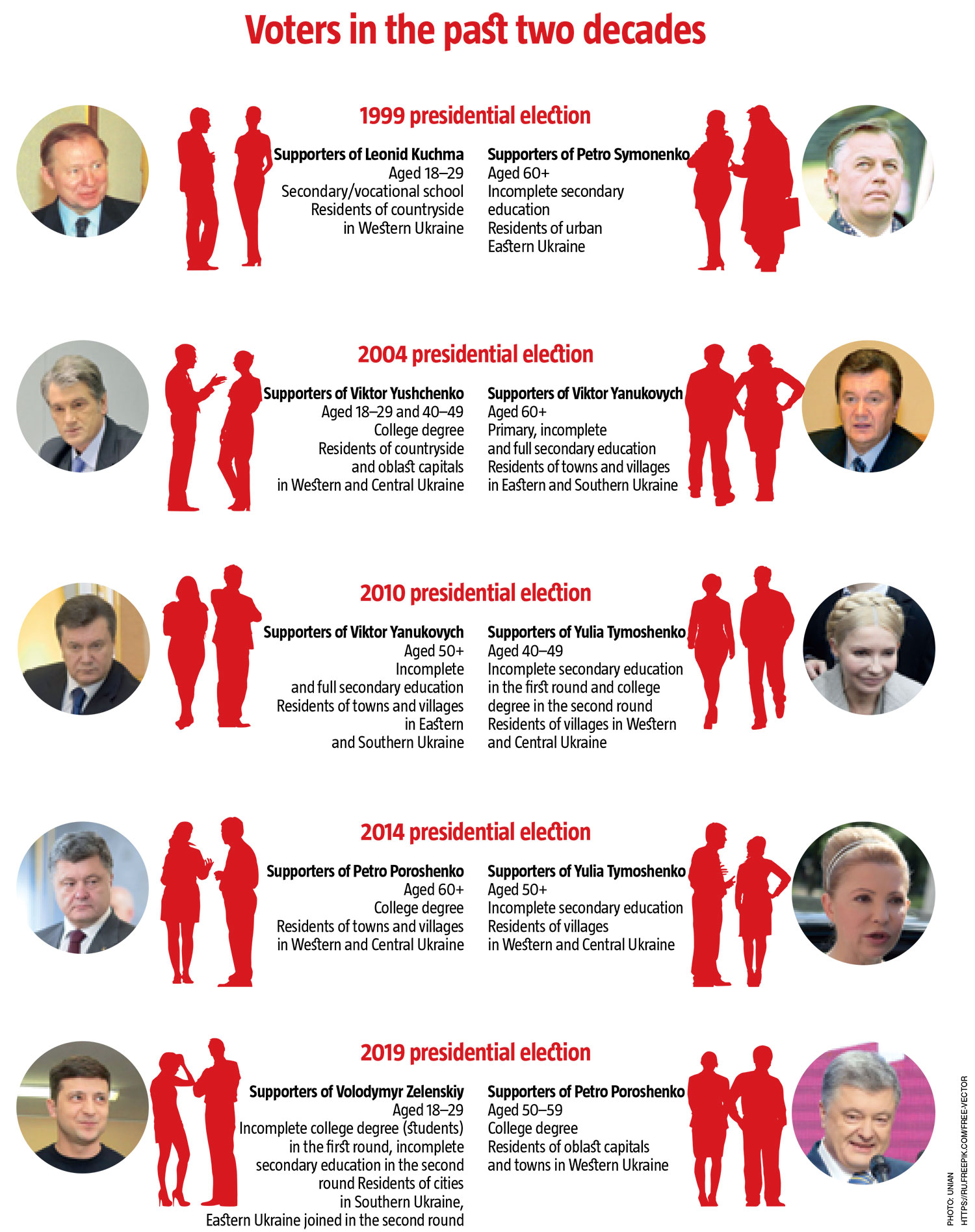Exit polls of the voters leaving polling stations to predict the outcome came into use in Ukraine’s elections in the late 1990s. Among other things, this allows sociologists to find out what electorate candidates or parties had by age, gender and education.
The first election with a wide-scale independently funded exit poll took place in 1999. It was (and still is) organized by the Democratic Initiatives foundation involving some top sociological companies. The Ukrainian Week used exit poll results regularly published by the Democratic Initiatives to find out who supported the leaders of presidential races throughout the past 20 years.
The 1999 election had two rounds with the incumbent Leonid Kuchma and Petro Symonenko, the leader of the Communist Party. The youth mostly supported Kuchma, his electorate shrinking with age. Pensioners prevailed in Symonenko’s electorate. In the second round, those aged 60+ let the leader of the Communists down. The highest share of those voting against all was in the 18-29 age group and among those with college degrees. Sociologists discovered that more Ukrainians voted for Kuchma and more Russians voted for Symonenko.
RELATED ARTICLE: Election 2019: Shifting positions
Society was highly polarized in the 2004 election when Viktor Yushchenko ran against Viktor Yanukovych. Sociologists assumed that fear, insincere answers or refusals to respond in polls could affect the reliability of the results. They decided to do the polling anonymously: the respondents would mark answers in the ballots on their own and put them in a box. Two companies, Socis and Social Monitoring, did exit polls via interview. The Razumkov Kyiv International Institute of Sociology used anonymous ballots. The latter showed a difference of 3.9% in favor of the opposition candidate Viktor Yushchenko.
Round two exit poll results were dramatically different from the figures announced by the Central Election Commission. Eventually, the Supreme Court of Ukraine decided that the voting violated the principles of election law and scheduled a re-vote.
Yushchenko was supported by Western and Central Ukrainians in all rounds, mostly countryside residents aged 40- and people with college degrees. Yanukovych’s electorate was 60+ residing in cities in Eastern and Southern Ukraine with secondary or vocational education. Yushchenko’s voters were evenly divided in terms of gender, while Yanukovych’s supporters included 58% of women. Generally, men and women are fairly even in their preferences in presidential elections in Ukraine.
In 2010, the competition was between Viktor Yanukovych and Yulia Tymoshenko. Eastern Ukrainian cities traditionally provided support to Yanukovych while the countryside in Western Ukraine voted for Tymoshenko. Voters with college degrees were reluctant to vote for both, giving somewhat more votes to Tymoshenko in the second round.
RELATED ARTICLE: What’s in a campaign platform?
Mobilized by Russia’s aggression in the East and Crimea, Ukrainians elected their President in one round in 2014. Freshly released from jail, Tymoshenko failed to compete with Poroshenko with her under 13%. Both competed for the countryside in Western and Central Ukraine. Poroshenko was supported in cities while Eastern Ukraine supported Mykhailo Dobkin. Both focused on older people. Oleh Liashko attracted the youth.
Five years later, Volodymyr Zelenskiy beat Poroshenko with an unprecedented margin, building his campaign on his TV series-based image of a president. He got 73% in the second round in absolute majority of oblasts, other than Lviv Oblast, and in all age, education and settlement categories. His electorate is concentrated in South and Eastern Ukraine and in big cities. These are mostly young people with unfinished secondary or vocational school. People with a college degree residing in Western Ukraine prevail in Poroshenko’s electorate. Many of the new President’s voters decided to support him in the last month before the election or later.

Translated by Anna Korbut
Follow us at @OfficeWeek on Twitter and The Ukrainian Week on Facebook

